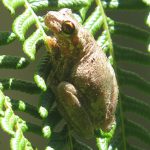BLEATING TREE FROG
Bleating Tree Frog: The little voice of the wet night
in the forest
Step into an eastern Australian forest after rain and the world feels newly minted—cool air edged with the clean scent of eucalyptus, damp leaves exhaling a peppery sweetness, trunks beaded with tiny droplets. Then it begins: a crisp, high bleat, like a lamb somewhere above your head. Another answers, then another, until the treetops feel alive with sound. This is the call of the Bleating Tree Frog, a tiny arboreal hunter whose voice travels far through the night.
Quick facts
| Feature | Detail |
|---|---|
| Scientific name | Litoria dentata |
| Size | 3–4 cm (adults) |
| Colour | Variable: bright green to brownish, often changing with light and temperature |
| Eyes | Large, excellent night vision; horizontal pupil |
| Range | Eastern Australia: southern Queensland and New South Wales (coastal and subcoastal) |
| Habitats | Forests, paperbark swamps, wetlands, gardens and urban parks with water nearby |
| Status | Not threatened (Least Concern), but locally affected by habitat loss and disease |
How to recognise it
- Colour-shifting skin helps with camouflage and temperature control—greener by day in foliage, browner at night or on bark.
- Smooth skin and prominent adhesive pads on fingers and toes for expert climbing.
- The call: a clear, repetitive bleat—sharp, insistent, and surprisingly loud for such a small frog.
Tip: If you hear what sounds like a tiny sheep high in the canopy on a humid night, you have likely found Litoria dentata.
Life among leaves and water
Bleating Tree Frogs are mostly arboreal. By day they hide in leaf axils, bark crevices, or dense shrubs, cool and still. At night, they come alive, moving with careful, deliberate steps, each toe pad pressing to bark with a soft tack, then releasing. The world they inhabit is textured: damp moss underfoot, smooth paperbark, the delicate patter of insects’ wings drifting through the understory.
Diet and ecological role
- Diet: mosquitoes, moths, beetles, small flies, and other invertebrates.
- Role: natural insect control. By keeping invertebrate numbers in check, they help maintain balance in wetland and forest food webs, and in gardens too.
Breeding and life cycle
- Season: generally October to March, often triggered by warm, rainy nights.
- Courtship: males gather near ponds, slow streams, or flooded ditches and call in chorus—their combined bleating can carry for hundreds of metres.
- Eggs: laid in small clumps in still or gently flowing water, often attached to submerged plants.
- Tadpoles: graze and grow over weeks to months before metamorphosing into tiny, bright-eyed froglets. Lifespan in the wild is several years, varying with habitat quality and predation.
Look-alikes and how to tell them apart
- Eastern Dwarf Tree Frog (Litoria fallax): smaller on average; call is a rapid, rattling chatter rather than a bleat.
- Tyler’s Tree Frog (Litoria tyleri): call is more of a creaking “door hinge” sound.
- Green Tree Frog (Litoria caerulea): much larger, deeper croak, often around buildings and water tanks.
If you are unsure, the call is your best guide—Bleating Tree Frogs really do sound like miniature sheep.
Living with Bleating Tree Frogs
You can support them at home and in local parks:
- Keep a fish-free pond or water dish with gently sloping edges and native aquatic plants.
- Plant dense, layered vegetation, including shrubs and grasses for shelter.
- Avoid pesticides and herbicides; these can harm frogs and their food.
- Retain leaf litter and logs to keep the ground cool and humid.
- Keep outdoor lights low or timed—while lights attract insects, excessive illumination can disturb nocturnal wildlife.
- If you must handle a frog (for rescue only), wet your hands first and keep contact brief.
Subtle challenges, clear opportunities
Although not currently endangered, Bleating Tree Frogs face:
- Habitat loss and fragmentation, especially of wetlands and paperbark swamps.
- Polluted runoff and altered water regimes in urban areas.
- Chytrid fungus disease, which affects many amphibians.
- Climate variability that changes breeding windows and water availability.
Conservation is practical: protect and restore wetlands, keep waterways clean, and retain tree cover near water. Local councils and community groups often run habitat plantings and wetland care days—joining in helps frogs, birds, and people alike.
A final note in the chorus
The Bleating Tree Frog is a small presence with a large voice, a reminder that much of the forest’s life unfolds after dark. Listen for that bright, sheep-like call on a warm, wet evening. Knowing the caller—and making space for it—turns a simple sound into a story of resilience, rain, and the living threads that hold Australia’s biodiversity together.

